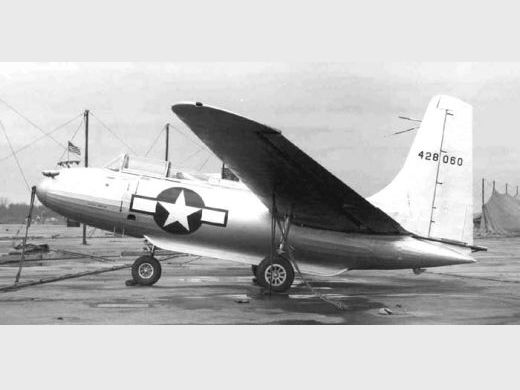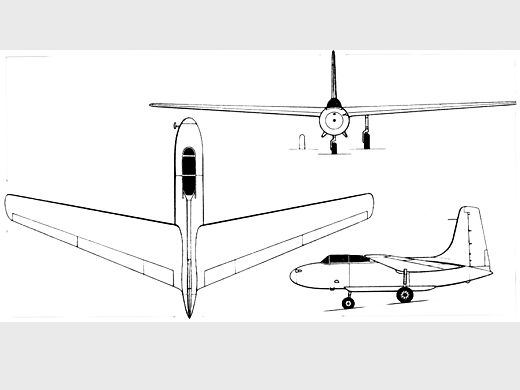
Cornelius XFG-1
| DONNÉES GÉNÉRALES |
| Année du premier vol (ou de design, si seul projet) |
1944 |
| Pays | USA |
| Designer(s) | CORNELIUS, George |
| Premier constructeur | Cornelius Aircraft Co. |
| Type d'appareil | Aile volante |
| Fonction | Militaire |
| SPÉCIFICATIONS TECHNIQUES |
| Envergure | 16.46 m |
| Longueur | 8.91 m |
| Hauteur | 3 m |
| Allongement | -- |
| Surface alaire | -- |
| Profil aile | -- |
| Masse à vide | -- |
| Masse maxi | 1330 kg |
| Charge alaire | -- |
| Vitesse mini | -- |
| Vitesse maxi | -- |
| Finesse maxi | |
| Taux de chute mini | -- |
| Nb sièges | 1 |
| Structure | -- |
AUTRES INFORMATIONS
| Constructeur(s) |
| ||||||
| Infos techniques | Flèche inverse très prononcée. | ||||||
| Histoire résumée | Planeur ravitailleur en vol pouvant embarquer plus de 2500 litres de carburant. The Cornelius XFG-1 was an aerodynamically unusual aircraft intended for an unusual military role. George Cornelius had been experimenting with aircraft featuring differentially variable incidence since the 1920s[1]. His first two machines were otherwise conventional but the third, the Cornelius Mallard from 1943 was not, being without a horizontal tailplane and having low aspect ratio and strongly forward swept wings. Though very different in detail, the XFG-1 built on the Mallard experience. The FG in its designation stood for fuel glider and its role was as a fuel transport. It was to be towed behind another aircraft rather like contemporary troop carrying gliders, but its fuselage tanks held 677 US gal[2] (2,563 l or 564 Imperial gal) of fuel. Since it was never deployed in action, its exact role remains unclear, but proposals seem to have included a piloted tow behind a C-47 or similar, the glider landing loaded on skids having jettisoned its wheels after take off; or a pilotless version towed behind a bomber, abandoned after fuel transfer.[1] The XFG-1 was a high wing monoplane, its wing set far back towards its fin. The wing was quite high aspect ratio and of modest forward sweep. Though the earlier Cornelius aircraft had wings that had their incidence variable in the air, the incidence on the XFG-1 could only be adjusted on the ground[1]. There was no horizontal tail. It had a simple fixed tricycle undercarriage and a conventional single seat cockpit. Two prototypes were built and 32 flights were made between them in 1944-5[1], though the first was lost to a spin, killing the pilot. On many of the flights, though not the fatal one, the pilot was Alfred Reitherman[3]. The fuel glider concept was abandoned at the end of World War II. Glider XFG-1 est conçu comme un avion expérimental purement, qui a été élaboré régime de ravitaillement en vol des bombardiers qui a effectué d'autres perquisitions. Selon les responsables de plan, pour augmenter la portée de l'avion qu'il devait remorquer un planeur-citerne (avec une réserve de carburant 2563 litres), lentement, il pompage du carburant et la production de découplage dès que les chars de la cellule est vide. Immédiatement planeur prévu de faire un sans pilote, que le processus de pompage irait à l'équipage de bombardiers. Néanmoins, le siège du pilote sur elle encore prévue. Une caractéristique intéressante de XFG-1 a été le balayage inverse de son aile. Planeurs ont été construits par Spartan, mais tous ont été libérés deux prototypes XFG-1 (numéros de série 44-28059 et 44 à 28.060), dont la première a survolé Octobre 11, 1944. Par la suite, une cellule a été interrompue pendant les essais en vol, et le second a continué à voler jusqu'à la fin de 1945 que le programme fermée pour cause de désespoir. | ||||||
| Liens personnalités | Pas de personnalité associée. |
SOURCES DOCUMENTAIRES
| Liens WEB | Site : Уголок неба (Coin de Ciel) . Note + 2 photos + plan 3 vues + specs. (2009-11-01 CL) Site : Wikipedia . Note. (2010-06-09 CL) Site : Aviation Enthusiast Corner . Note + 1 photo + specs. (2010-06-09 CL) Site : Taringa . 3 photos. Page en espagnol. (2010-06-09 CL) Site : Raravia (site de Fabián Capecchi) . Note + 1 photo. Page en espagnol. (2010-06-09 CL) Site : Forum RC Groups . Sujet Military gliders. (2010-06-09 CL) Site : Nuricom (Klaus Niegratschka) . Plan 3 vues. (2011-04-12 CL) Site : Members Site de Klaus Niegratschka . Page du XFG-1. Note + dessin + photo.. (2011-04-13 CL) |
| Livres | Pas de livre référencé. |
| Autres sources | Soaring septembre-octobre 1955 p 25. Texte + photo. The aircraft of George Cornelius, RC Soaring Digest, vol. 30 n° 9-10 2013, p 31-41. Texte + plan 3 vues. |

Team J2mcL © 2003 -
- Pages optimisées pour Mozilla Firefox

